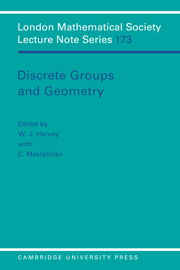Book contents
- Frontmatter
- Contents
- Preface
- Symmetries of modular surfaces
- Lifting group actions to covering spaces
- A combinatorial approach to the symmetries of M and M–l Riemann surfaces
- Inequalities for Pell equations and Fuchsian groups
- The Euler characteristic of graph products and of Coxeter groups
- Infinite families of automorphism groups of Riemann surfaces
- Planar hyperelliptic Klein surfaces and fundamental regions of NEC groups
- An example of an infinite group
- Moduli of Riemann surfaces with symmetry
- Modular groups – geometry and physics
- On automorphisms of free products
- The growth series of the Gieseking group
- Exceptional representations of PSL2(q) of monodromy genus zero
- On the rank of NEC groups
- The geometry of bending quasi-Fuchsian groups
- Farey series and sums of continued fractions
- Commensurability classes of two-generator Fuchsian groups
- Limit points via Schottky pairings
- Diagonalizing Eisenstein series III
- Some remarks on 2-generator hyperbolic 3-manifolds
- Uniformization, graded Riemann surfaces and supersymmetry
- Generating sets for finite groups
- Group actions on trees with and without fixed points
Group actions on trees with and without fixed points
Published online by Cambridge University Press: 10 December 2009
- Frontmatter
- Contents
- Preface
- Symmetries of modular surfaces
- Lifting group actions to covering spaces
- A combinatorial approach to the symmetries of M and M–l Riemann surfaces
- Inequalities for Pell equations and Fuchsian groups
- The Euler characteristic of graph products and of Coxeter groups
- Infinite families of automorphism groups of Riemann surfaces
- Planar hyperelliptic Klein surfaces and fundamental regions of NEC groups
- An example of an infinite group
- Moduli of Riemann surfaces with symmetry
- Modular groups – geometry and physics
- On automorphisms of free products
- The growth series of the Gieseking group
- Exceptional representations of PSL2(q) of monodromy genus zero
- On the rank of NEC groups
- The geometry of bending quasi-Fuchsian groups
- Farey series and sums of continued fractions
- Commensurability classes of two-generator Fuchsian groups
- Limit points via Schottky pairings
- Diagonalizing Eisenstein series III
- Some remarks on 2-generator hyperbolic 3-manifolds
- Uniformization, graded Riemann surfaces and supersymmetry
- Generating sets for finite groups
- Group actions on trees with and without fixed points
Summary
In [4; 3.1] it is shown that an R-tree T, on which a group G acts, has a unique minimal invariant subtree if there are elements of G with no fixed points. The situation where each element of G fixes some point of T splits into two cases depending on whether the action is bounded or not. In the unbounded case, when T has no invariant subtree, it is shown in Theorem 1 that G is given by an infinite tower of subgroups. In [3] Chiswell constructs an action on a tree that corresponds to a given Lyndon length function defined on G. This construction is used in Theorem 2 to establish a necessary and sufficient condition for two length functions to arise from the same action of G on some tree T, again in the case where each element of G fixes some point of T.
An R-tree T is a non-empty metric space, with metric d, such that there is no subspace homeomorphic to a circle, and for any two points u, u ∈ T there is a unique isometry α : [0, r] → T, with α(0) = u, α(r) = u, where r = d(u, u). It is shown in section 4 of [5] that the completion of an R-tree is again an R-tree. The definition is originally due to Tits [8], where completeness is assumed. In this paper all R-trees will be assumed to be complete. This allows the results of Theorem 1 to be economically expressed.
- Type
- Chapter
- Information
- Discrete Groups and Geometry , pp. 243 - 248Publisher: Cambridge University PressPrint publication year: 1992



